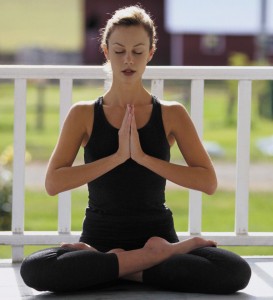Introduction to Yoga

Yoga (YOG in Sanskrit means union) is a lifestyle to realize the supreme. It is one of the ways to get liberated from the cycle of birth and death, and breaks free from the pain and pleasures of reincarnation. Being born as a human is an opportunity to achieve this salvation. Yoga is known in the west mostly as physical postures with health benefits. Yoga in the east is a spiritual, private, and a personal experience, aspiring salvation.
Yoga should be learned from a Guru or a master. As with any other activity, consistent and disciplined practice is the key to learning. The classical teachings of Yoga have established 8 components. These have been interpreted as 8 parts or practices or steps or sequence, in Yoga. The eight fold path of Patanjali Yoga is composed of: Yama, Niyama, Asana, Pranayama, Pratyahaar, Dhaarna, Dhyaan, and Samadhi. Yama and Niyama are related to lifestyle, Asana and Pranayama are physical exercises and the rest are related to meditation. One school of thought focuses on controlling the mind first (through meditation) and the body later. Other focuses on physical purification procedures (Asanas and Pranayama) as a prerequisite to control the mind.
Yama is the practice of Nonviolence in speech and behavior; Truth in words and action; Lawful and honest conduct; Disciplined life; and Attitude of material detachment. Niyama refers to daily practice of cleanliness of body (bath, defecation, urination) and mind (study of spiritual and religious scriptures, attitude of contentment, humility, and thankfulness).
Asanas are physical postures which have health benefits when performed according to ones constitution (prakruti or doshas). You do not have to be a contortionist to do Asanas. You only need a carpeted floor with a soft cotton sheet spread over it to do the asanas. Wear loose fitting and comfortable cotton clothes. There are no strict contraindications but do not do anything that causes discomfort. “No pain no again” definitely does not work here. Asanas are ideally done early in the morning after bowel evacuation, in a well ventilated room. Surya Namaskar (Sun salutation) is performed first, followed by alternating forward and backward bending asanas, spinal twists, and inverted asanas are done at the end.
Pranayama are breathing exercises which balance the sympathetic and parasympathetic nervous systems through their effect on the nasal cycle. These are always done after the asanas and before the practice of meditation. Breathe control in an integral part of Yoga. Through breath, body and mind can be controlled. Mudras are hand gestures and Mantras are specific spoken words or chants (like OM or Gayatri mantra). They all have health benefits when performed according to ones constitution (prakruti or doshas).
Pratyahaar is the practice of control of the mind over the five senses through meditation, and their withdrawal from the external world. Dhaarna is an early meditative state of focused concentration of the mind, possible only after the withdrawal of the five senses. Dhyaan is a state of meditation where the mind focuses on, and identifies with the soul. Samadhi is a deep meditative state where the soul becomes one with the universal consciousness (Parmaatma).
The ultimate goal is a happy, healthy and balanced life with respect and humility towards one and all, and realization of the ultimate truth.




